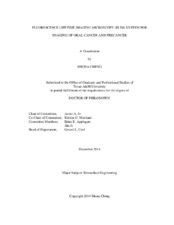| dc.description.abstract | Standard diagnosis of oral cancer is based on visual inspection and palpation by a clinician followed by histological examination of one or more tissue biopsies. Choosing the right location for biopsies, which represents the most severe lesion, is difficult and subjective to each clinician’s experience, especially for precancer lesions which are often diffuse, multifocal, and clinically indistinguishable from benign lesions. This may lead to low diagnosis sensitivity. The aim of this dissertation is to design a more sensitive and objective screening tool to guide the biopsy of oral cancer and precancer.
Fluorescence lifetime imaging microscopy (FLIM) is a noninvasive optical technique which is able to detect the information of tissue metabolism and biochemistry based on fluorescence as a source of contrast. Recently, there is increasing interest in the application of multispectral FLIM for medical diagnosis. Central to the clinical translation of FLIM technology is the development of compact and high-speed clinically compatible systems. In this dissertation, four multispectral FLIM systems were designed and built. A bench-top multispectral FLIM system was first built and combined with reflectance confocal microscopy (RCM) for the preclinical validation by imaging a hamster cheek pouch model of oral carcinogenesis. After that, in order to facilitate in vivo imaging of human oral mucosa, three different multispectral FLIM endoscopes were designed. The first FLIM endoscope was built based on a fiber bundle and the time-gated implementation by an intensified charged-coupled device (ICCD). The system was validated by imaging a hamster cheek pouch model of oral carcinogenesis. To achieve faster imaging speed and more accurate lifetime estimation, two rigid handheld FLIM endoscopes were built based on a pulse sampling implementation. These two handheld endoscopes were different in weight and size. The more compact one might serve as the clinical prototype for oral cancer and precancer detection. Both systems were validated by imaging the human oral biopsy ex vivo and human oral mucosa in vivo. The development of these systems will facilitate the evaluation of multispectral FLIM for oral cancer and precancer detection. | en |


